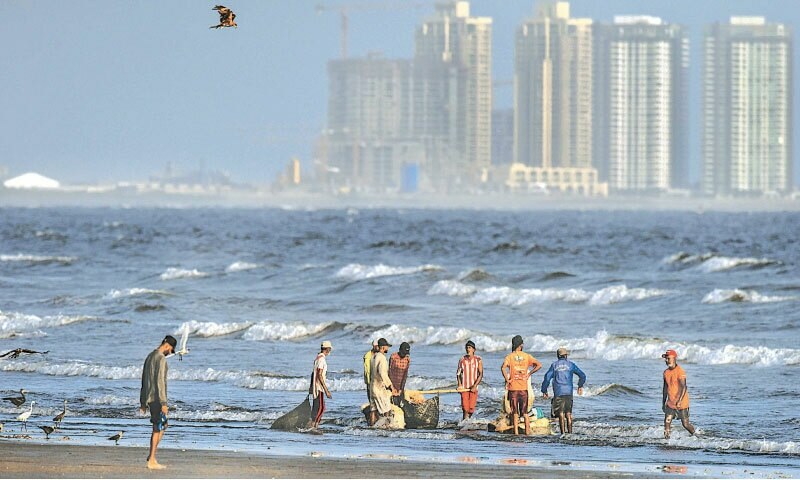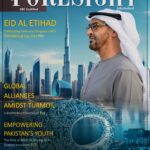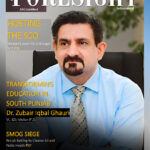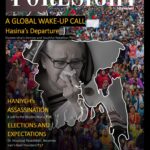Recent attempts to ‘beautify’ Karachi’s Seaview have resulted in damaging environmental and social consequences that are often ignored by those in power.
Karachi’s Seaview is not merely a beach; it is an essential public space that has long served as a meeting ground for the city’s diverse population. For generations, families have come here to spend their leisure time, hawkers have lined the shore offering snacks and trinkets, and fishermen have carried on their traditional livelihoods in the shallow waters.
In a city marked by stark social and economic divides, Seaview stands as one of the few spaces where these distinctions momentarily dissolve, and the rhythm of life is dictated by the sea rather than societal boundaries. It remains a rare and invaluable commons, embodying Karachi’s shared heritage and collective identity.
But, like much of Karachi, Seaview is now caught in the tide of rapid urban transformation, where priorities of infrastructure, ‘aesthetics’, and commercial gain have taken precedence over inclusivity, community and sustainability.
In recent years, the Clifton Cantonment Board (CBC) has undertaken an ambitious landscaping project that has significantly altered the character of Seaview. Between 2020 and 2023, Beach Avenue was transformed into a lush public park, extending from the children’s entertainment establishment Chunky Monkey to the fast food outlet McDonald’s. This ‘beautification’ effort introduced 500 coconut trees, 150 palm trees, and over half a million bougainvillea and petunia plants, among other greenery.
Recent municipal attempts to ‘beautify’ Karachi’s Seaview and alter its landscape have been hailed by middle class and upper class visitors but have also resulted in damaging environmental and social consequences that are often ignored by those in power. From local fishermen to hawkers, many are concerned that their sources of livelihood now hang in the balance and that the long-term ecological impact may be profoundly problematic…
Hundreds of colourful flowers and salt-tolerant grasses were also planted to prevent sand and pollution from affecting the area. While the project aimed to enhance the aesthetic appeal and address environmental concerns such as sandstorms and traffic disruptions, it also reimagined Seaview as a controlled recreational space, with sitting areas, tree-lined paths, and modern amenities.
However, this new vision of Seaview must be understood within a broader context of urban development. The transformation of this public space is part of a larger wave of infrastructural changes, including the controversial reclamation of land for projects such as ‘China Port.’ This artificial breakwater, constructed in 2012 using interlocking tetrahedron-shaped concrete blocks, has extended the coastline and pushed the sea back by 1.4 kilometres.
Framed as part of the city’s ‘modernisation’ efforts, these developments have come at a significant cost to both the physical and social fabric of Seaview. The question now arises: who truly benefits from these changes, and at what cost to the communities who have long depended on this space?
Interviews with the public and local hawkers offer insights into how these alterations to the coastal landscape and the introduction of new amenities have affected their daily lives. These perspectives are crucial in understanding the full impact of urban growth on both the environment and the people who have long called this space home.
A SEA PUSHED BACK: THE ENVIRONMENTAL TOLL
The retreat of the sea at Seaview stands as one of the most profound transformations the area has undergone, marking a fundamental shift in the city’s relationship with its coastline and natural environment.
In the past, during high tide, the waves would reach Beach Avenue, establishing a natural connection between the city and the sea. This proximity not only defined the coastline’s identity but also sustained a thriving ecosystem dependent on the natural rhythm of the tides. Today, that connection has been severed, replaced by a stretch of reclaimed land — a human-made accomplishment that has come at a considerable ecological cost.
Despite the general public’s lack of awareness about the reasons behind the sea’s displacement, most have expressed a preference for the new, more structured environment that has emerged. While a small group nostalgically favours the natural shoreline along Beach Avenue, the majority have adapted to the change, seemingly accepting the sea’s retreat. The transformation has certainly created a new dynamic, with modern amenities catering to families and tourists, including enhanced security and cleaner facilities. To some, this represents an improvement.
However, the absence of consultation with locals, including residents, fishermen and small business owners such as hawkers around Seaview, regarding these significant changes raises critical concerns. The long-term consequences of such developments on both the environment and the cultural identity of the Seaview community — which is deeply connected to the coastal ecosystem, fishing traditions and local livelihoods — remain uncertain and contentious.
Local fishermen, primarily from the nearby coastal communities of Shireen Jinnah Colony and Ibrahim Hyderi, whose families have depended on these waters for generations, now find themselves in a crisis. Fish stocks have dwindled due to both pollution and the environmental impacts of coastal reclamation, threatening their livelihoods.
As one fisherman laments, “We used to have good catches when the fish came close to shore during the high tide. Now, we have to go farther into the sea and still come back with less.” Another echoes this sentiment, adding, “Pollution has ruined the waters.”
This loss of livelihood is not merely an economic hardship. It is a disconnection from centuries-old traditions that have shaped the communities along the coast. Their intimate knowledge of the tides, currents and marine life, passed down through generations, now appears irrelevant in an environment altered by human interference.
The plight of the fishermen is dire. Once integral to the cultural and economic fabric of Seaview, their traditional livelihood has been severely affected by environmental changes. The receding coastline and escalating pollution have decimated fish stocks, making fishing an increasingly unsustainable way of life. “We used to rely on the tides to bring the fish closer, but now the sea is so far away, and what’s left is polluted,” one fisherman says.
As the sea moves further from their reach and the waters become increasingly tainted, the fishermen are forced to venture farther out, incurring rising costs for fuel and equipment, while their returns continue to diminish. The large-scale construction and land reclamation projects along the coastline have compounded their struggles, disrupting marine habitats and further depleting fish populations, destabilising the delicate balance of the coastal ecosystem.
For the fishermen, the transformation is also a profound cultural loss. “We’ve been fishing here for generations,” a fisherman tells me, “but now it feels like we’re losing everything. The sea is no longer ours.” His words reflect the deep sense of alienation and displacement felt by many in the community as they are pushed farther from their traditional sources of income and culture.
The construction of the China Port has further exacerbated the situation. While the port’s development is intended to enhance trade and connectivity, it has come at an alarming environmental cost. The land reclamation required to build the port has not only displaced the sea but also disrupted essential tidal patterns and sediment flow, both of which are critical for the health of coastal ecosystems.
This disruption has caused shoreline erosion, destroyed marine habitats, and disturbed the ecological balance that once thrived along the coast. Additionally, the rise in shipping activity has led to oil spills and waste discharges, worsening water quality and endangering marine life. To address these issues, there needs to be a more responsible approach to development, which considers both environmental protection and the preservation of local livelihoods.
A PUBLIC SPACE FOR WHOM?
Seaview remains a popular destination, especially for families, thanks to improvements such as sitting areas, better security, and modern amenities like seating areas and bathrooms. These changes have made the area more organised and appealing for middle- and upper-class visitors seeking clean and safe spaces for leisure. However, these developments have largely ignored the needs of the poorer communities who are either pushed out or not catered to, leaving them with limited access to the coastline.
However, beneath the surface of these developments lies a deeper issue: speculation is growing about the involvement of land grabbers and powerful entities such as the Cantonment Board Karachi (CBC), who stand to benefit financially from these developments. The projects, marketed as symbols of urban progress, raise important questions: who is truly benefiting from these changes, and what are the social, economic, and environmental costs? The loss of natural coastal ecosystems, displacement of vulnerable communities, and long-term ecological damage are significant issues that need to be addressed.
Interviews with hawkers, who have long been a part of Seaview’s vibrant atmosphere, provide a more complex picture. While some hawkers have benefitted from increased foot traffic, many others feel marginalised by the transformation of the space. Relocated from their positions near the main road to less accessible areas, they have lost their connection with passing customers, diminishing their business prospects. This move, made without consultation or consideration of their livelihoods, has left many of them also feeling alienated and displaced from what was once a thriving economic and cultural hub.
The transformation of Seaview, once a vibrant space animated by hawkers with their food stalls, trinkets, and games, now reflects the harsh realities faced by these informal workers in an increasingly commercialised environment. As one hawker puts it, “We are happy to see more people here, but at what cost? The money we make is never enough.”
This sentiment speaks to the fragile economic conditions under which these workers operate, where each day brings a new challenge to survival.
Hawkers claim they pay Rs 100-300 daily to officials, primarily from the CBC, as ‘bhata’ or protection money, a practice that has persisted from long before the recent landscaping changes. While this burden is not new, the growing commercialisation of the area and increased regulation have only exacerbated their financial struggles. The extra cost adds another layer of inequity, further marginalising these already vulnerable workers in an environment that continues to favour wealthier groups.
These concerns highlight the uneven and often unjust effects of the redevelopment on the hawkers, revealing the underlying contradictions between the development’s vision of urban progress and the lived realities of those who have sustained the area for years.
The redevelopment of Seaview has altered not only its physical landscape but also its cultural dynamic — catering to an affluent, sanitised vision of leisure and consumption. This shift, though presented as progress, has deepened the divide between the urban elite and the marginalised populations that rely on the coastline for their livelihoods. The question arises: should urban development prioritise aesthetics and leisure for some, or should it also include the rights and needs of all?
The displacement of informal workers, such as hawkers and fishermen, is not just an issue of economic exclusion — it also has significant cultural implications. The hawkers, with their daily routines, distinctive sounds, and the aromas of their food, were an integral part of the Seaview experience. Now, as their livelihoods are undermined by urban transformation, there is a risk that this familiar aspect of the area will be lost.
What was once a place of dynamic interaction where the urban and the natural coexisted is now turning into a polished, curated space that caters to a specific demographic. This transformation is indicative of a larger issue within urban development in Pakistan — where the needs of marginalised communities are often overlooked in favour of top-down solutions that fail to recognise the value of their contributions.
If Seaview is to remain a genuine public space, its redevelopment must go beyond superficial changes. A truly inclusive approach to urban development requires policies that value and protect the rights of informal vendors while addressing the needs of all user groups. There must be a concerted effort to engage stakeholders in the planning and decision-making processes, ensuring that their voices are heard and respected.
Without this, Seaview risks becoming a space for only a select few, reinforcing the broader pattern of exclusion that characterises many urban developments. It serves as a powerful reminder that, in the rush for progress, the most vulnerable often bear the heaviest costs, and the essence of a place can be lost in the pursuit of an idealised vision of the future.
THE SOCIAL AND POLITICAL CONTEXT
The transformation of Seaview is a reflection of broader trends in Karachi’s urban development, where so-called progress often undermines both inclusivity and environmental sustainability. These projects, though presented as physical improvements, are deeply interwoven with the socio-political context and the power dynamics that shape the city’s rapid urbanisation.
To fully grasp the significance of Seaview’s transformation, one must consider the political backdrop in which it unfolds. Allegations of land grabbing are central to the controversy surrounding this redevelopment, casting doubt on the transparency and accountability of the entire process.
Reclaimed land is already being used for commercial and residential development. As one hawker puts it, “Big people are taking over this place. They say it’s for the public, but we know who really benefits.”
This reflects a broader sense of mistrust surrounding the project, which, despite being promoted as a public amenity, often serves the interests of the city’s elite. The development seems to prioritise wealth consolidation and exclusive access, while limiting opportunities for the broader public, particularly those from lower-income communities.
A key concern among both the public and hawkers is the environmental impact of new constructions on reclaimed land. The question of sewage disposal is particularly pressing, with many worried that the waste generated by new residential developments will eventually flow into the sea, worsening an already dire pollution problem.
Despite these environmental concerns, there is a shared desire for more amenities, including better sitting spaces, to improve the recreational experience for both families and hawkers alike. This reflects a broader tension between the economic benefits of development and the environmental and social costs that come with it.
The voices of local communities — hawkers, fishermen, and long-time residents — are largely excluded from decision-making. As one hawker points out, “They never asked us what we need or how this will impact our work. We only found out when they started pushing us further away.” When asked about this, the CBC has not provided clear responses regarding the concerns raised by these groups.
The redevelopment of Seaview also raises critical questions about accountability and governance. Who decides how public spaces are developed, and who benefits from these decisions? The absence of inclusive planning processes undermines the rights of marginalised communities and poses a serious threat to the long-term sustainability of Karachi’s growth.
Activists and community leaders have long advocated for a more participatory approach to urban development — one that involves all stakeholders, from policymakers and developers to local residents and workers, in the decision-making process.
For Seaview to truly embody progress, its redevelopment must go beyond superficial aesthetics and commercial success. It must address the socio-political inequalities that it inadvertently perpetuates, responding to the needs of those who are most affected by these changes. Inclusive public spaces are not merely about physical accessibility, they are about creating environments in which diverse communities can coexist, contribute and thrive.
Without these considerations, Seaview risks becoming a symbol of exclusion and exploitation rather than a model for equitable urban development. By alienating the very people it purports to serve, it would lose the authenticity that has made it a unique and beloved space for generations. The question, then, is not just about creating a more modern Seaview, but about ensuring that the development of the space is truly inclusive. The true measure of urban progress lies not in a glossy image of modernity but in the ability to foster social justice, environmental sustainability and inclusivity for all.
LANDSCAPING IN AN ALTERED ENVIRONMENT
Meanwhile, the efforts to beautify Seaview’s reclaimed land with trees and flowers have also been stymied due to the high salinity of the soil, which hampers plant growth. Many trees fail to take root, and the flowers, despite their temporary vibrancy, are often picked by visitors.
A worker responsible for maintaining the greenery talks about the challenge: “We plant trees, but the soil isn’t friendly to them. Many die within weeks, and visitors picking flowers make it worse.”
These challenges point to a broader issue in urban development: the difficulty of introducing sustainable, long term greenery in environments that have been altered by human intervention. The salinity of the soil is just one of the factors contributing to the failure of these efforts. While beautification projects may create an immediate visual appeal, they do little to address the deeper ecological issues at play.
As architect and urban planner Arif Hasan points out, “The Clifton beach could have been left as a beach, and attempts to turn it into a park shouldn’t have been made, because the salinity and the monsoon winds will kill the plants. What could have been a lovely sandy beach is going to be a ruined ‘garden.’”
The failure to establish permanent greenery highlights the larger problem facing cities like Karachi — urban development that overlooks the natural environment, attempting to impose artificial solutions rather than working with the inherent challenges of the landscape. As these projects fail to thrive, they serve as a stark reminder that ecological considerations cannot be sidelined in the rush to develop urban spaces.
Sustainable development requires an understanding of the local environment and a more nuanced approach to urban planning, one that addresses the realities of the landscape rather than attempting to impose idealised solutions.
A WAY FORWARD
The redevelopment of Seaview offers an opportunity to reshape urban planning with a focus on sustainability, inclusivity and ecological preservation. In an era where urban expansion often neglects environmental responsibility, it is vital to prioritise sustainable development, ensuring that aesthetic and recreational goals do not compromise natural resources or local livelihoods. Thoughtful planning should balance urban progress with environmental stewardship, integrating green spaces, safeguarding coastal ecosystems, and ensuring equitable access for all.
Environmental rehabilitation must be at the core of Seaview’s redevelopment, focusing on critical issues such as sewage treatment, environmental degradation, and marine life restoration. The project should emphasize the restoration of natural habitats to enhance the area’s ecological health and ensure long-term sustainability.
Equally important is the active involvement of local communities — hawkers, fishermen and residents — in the planning process. Their insights and participation will help shape a redevelopment that meets their needs, fosters a sense of ownership, and creates an inclusive, resilient public space.
Adapting to coastal conditions such as salinity is also crucial. Using salt-tolerant plant species can enhance Seaview’s aesthetic while ensuring sustainability. Raising awareness about environmental conservation through educational programmes will help foster a culture of respect for nature and ensure the success of the redevelopment.
Seaview’s transformation highlights the delicate balance between urban growth and ecological preservation. The challenge lies in prioritising both progress and the preservation of the social and environmental fabric that makes Seaview unique. With careful, inclusive, and sustainable planning, Seaview can serve as a model for urban development that respects both people and the environment.
The writer is an architecture student at the National College of Arts (NCA) Lahore, and an intern at urban planner and architect Arif Hasan’s office.
He can be reached at aliahmedqureshi2000@gmail.com
Published in Dawn, EOS, February 2nd, 2025
- Desk Reporthttps://foresightmags.com/author/admin/











